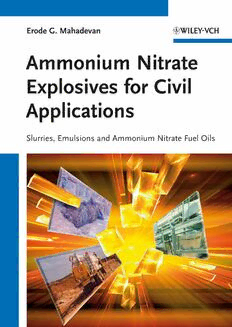Table Of ContentErodeG.Mahadevan
AmmoniumNitrateExplosivesfor
CivilApplications
RelatedTitles
Koch,Ernst-Christian Agrawal,J.P.,Hodgson,R.
Metal-Fluorocarbon Based OrganicChemistryof
EnergeticMaterials Explosives
2012 2007
ISBN:978-3-527-32920-5 ISBN:978-0-470-02967-1
Lackner,M.,Winter,F.,Agarwal,A.K. Kubota,N.
(eds.)
Propellants andExplosives
Handbook ofCombustion
ThermochemicalAspectsofCombustion
2010 2007
ISBN:978-3-527-32449-1 ISBN:978-3-527-31424-9
Agrawal,J.P. Teipel,U.(ed.)
High EnergyMaterials EnergeticMaterials
Propellants,ExplosivesandPyrotechnics ParticleProcessingandCharacterization
2010 2005
ISBN:978-3-527-32610-5 ISBN:978-3-527-30240-6
Meyer,R.,Ko¨hler,J.,Homburg,A.
Explosives
2007
ISBN:978-3-527-31656-4
Erode G. Mahadevan
Ammonium Nitrate Explosives for
Civil Applications
Slurries, Emulsions and Ammonium Nitrate Fuel Oils
TheAuthor AllbookspublishedbyWiley-VCHare
carefullyproduced.Nevertheless,authors,
Dr.ErodeG.Mahadevan editors,andpublisherdonotwarrantthe
TechnologyConsultant informationcontainedinthesebooks,
C-22VikrampuriColony includingthisbook,tobefreeoferrors.
Secunderabad500009 Readersareadvisedtokeepinmindthat
India statements,data,illustrations,procedural
detailsorotheritemsmayinadvertentlybe
inaccurate.
LibraryofCongressCardNo.:appliedfor
BritishLibraryCataloguing-in-Publication
Data
Acataloguerecordforthisbookisavailable
fromtheBritishLibrary.
Bibliographicinformationpublishedbythe
DeutscheNationalbibliothek
TheDeutscheNationalbibliothek
liststhispublicationintheDeutsche
Nationalbibliografie;detailedbibliographic
dataareavailableontheInternetat
<http://dnb.d-nb.de>.
2013Wiley-VCHVerlag&Co.KGaA,
Boschstr.12,69469Weinheim,Germany
Allrightsreserved(includingthoseof
translationintootherlanguages).Nopart
ofthisbookmaybereproducedinany
form–byphotoprinting,microfilm,orany
othermeans–nortransmittedortranslated
intoamachinelanguagewithoutwritten
permissionfromthepublishers.Registered
names,trademarks,etc.usedinthisbook,
evenwhennotspecificallymarkedassuch,
arenottobeconsideredunprotectedbylaw.
Composition LaserwordsPrivateLtd.,
Chennai,India
PrintingandBinding MarkonoPrintMedia
PteLtd,Singapore
CoverDesign AdamDesign,Weinheim
PrintedinSingapore
Printedonacid-freepaper
PrintISBN:978-3-527-33028-7
ePDFISBN:978-3-527-64570-1
ePubISBN:978-3-527-64569-5
mobiISBN:978-3-527-64571-8
oBookISBN:978-3-527-64568-8
V
Contents
Acknowledgment XI
Preface XIII
1 ClassificationofExplosives 1
1.1 InitiationSensitivity 1
1.2 Size 1
1.3 Usage 2
1.4 PhysicalForm 2
2 ExplosiveScience 5
2.1 Introduction 5
2.1.1 LowExplosives 5
2.1.2 HighExplosives 5
2.2 InitiationandDetonation 6
2.2.1 Mechanism 6
2.3 PropagationandDetonation 7
2.3.1 Propagation 7
2.3.2 Detonation 8
2.3.2.1 Ideal/NonidealDetonation/CriticalDiameter/IdealDiameter 9
2.3.2.2 DetonationPressureandVelocity 9
2.4 ReactionChemistryinExplosives 11
2.4.1 HeatofReaction 11
2.4.2 RulesofHierarchy 12
2.4.3 CalculationofOxygenBalanceandFuelValues 12
References 13
3 AmmoniumNitrateExplosives 15
3.1 Introduction 15
3.1.1 Chronology 15
3.2 DesignofCommercialExplosives 16
3.2.1 ImportanceofOxygenBalance 16
3.2.2 Physical,Performance,andSafetyRequirements 17
VI Contents
3.3 Tests 17
3.3.1 BallisticMortarTest 18
3.3.2 TrauzlLeadBlockTest 19
3.3.3 VelocityofDetonation(VOD) 20
3.3.4 GapTestandContinuityofDetonationTest 22
3.3.5 AquariumTest 23
3.3.6 DoublePipeTest 23
3.3.7 CylinderTest(CrushingStrength) 24
3.3.8 PlateDentTest 24
3.3.9 UnderwaterTest(UWT) 24
3.3.10 CraterTest 26
3.4 AssessmentofSafetyandStabilityCharacteristics 27
3.4.1 ImpactTest 27
3.4.2 TorpedoFrictionTest 27
3.4.3 AcceleratedHotStorage(ageingTest) 27
3.4.4 ColdTemperatureStorageTest 28
3.4.5 ThermalStabilityTestsUsingDTAandTGAProcedures 28
3.5 Summary 29
References 29
4 AmmoniumNitrateandAN/FO 31
4.1 IntroductionandHistory 31
4.2 PhysicalandChemicalPropertiesofAmmoniumNitrate 32
4.2.1 BasicData 32
4.2.2 DecompositionChemistryofAN 32
4.2.3 PhaseTransitioninANanditsImportanceinExplosives 33
4.3 ManufactureofAmmoniumNitrate 35
4.3.1 PrilledAmmoniumNitrate 36
4.4 AmmoniumNitrateFuelOilExplosives 39
4.4.1 Background 39
4.4.2 AN/FOManufacture 39
4.4.2.1 MixingProcessandEquipment 39
4.4.2.2 ContinuousProcess 40
4.4.2.3 BulkDeliverySystems 40
4.4.3 PropertiesofAN/FO 41
4.4.3.1 Physical 41
4.4.3.2 OilAbsorbencyandPorosity/BulkDensity/CrushingStrength 41
4.4.3.3 ResistancetoEffectofTemperatureCycling 44
4.4.4 CharacteristicsofANFO 45
4.4.4.1 Density/Strength 45
4.4.4.2 StrengthoftheAN/FOExplosive 46
4.4.4.3 EnergyContentofAN/FO 46
4.4.4.4 VelocityofDetonationandEffectivePriming 47
4.4.4.5 MechanismofDetonationPropagationinAN/FO 49
4.4.4.6 InfluenceofFuel 50
Contents VII
4.4.4.7 EffectofMoisture/WetBoreholes/Water-ResistantAN/FO 50
4.4.4.8 Water-ResistantAN/FO 52
4.4.4.9 IncreasingtheEnergyofAN/FOanditsFumeCharacteristics 52
4.4.5 SafetyConsiderationsinAN/FO 55
4.4.6 Summary – AN/FOExplosives 56
4.4.7 QualityChecks 56
References 58
FurtherReading 58
5 SlurriesandWaterGels 59
5.1 Development 59
5.2 Design 59
5.2.1 Large-DiameterPackagedProduct(WaterGels) 60
5.2.2 ListofIngredients 60
5.2.3 Small-Diameter,Cap-SensitiveWaterGels 60
5.2.4 BulkDeliveryProduct 61
5.2.5 BasicConceptsofFormulation 61
5.2.5.1 OxygenBalance 61
5.2.5.2 ThumbRulesforDesign 62
5.2.5.3 RoleofWater 63
5.2.5.4 BasicCompositionandProcess 65
5.3 ProcessTechnology 66
5.3.1 BatchProcess 66
5.3.2 ContinuousProcess 68
5.3.3 PackagingSystems 68
5.4 QualityChecks 71
5.4.1 RawMaterials 71
5.4.2 EndProductSpecification 73
5.4.2.1 DevelopmentofNewFormulations 73
5.4.3 RoleofAluminuminWaterGelsandSlurryExplosives 74
5.4.3.1 AtomizedandFlakePowders 74
5.4.3.2 AluminumWaterReaction 78
5.4.3.3 ImportantTestsforALPowderforUseinAN-BasedWaterGel
Explosives 80
5.4.4 In-ProcessandFinishedProductChecks 84
5.4.4.1 OxidizerBlendComposition 84
5.4.4.2 SolidIngredients 85
5.4.4.3 LiquidIngredients 85
5.4.4.4 Mixing 85
5.4.4.5 Packing 86
5.4.5 PerformanceTests 86
5.4.6 SafetyTests 87
5.4.6.1 GapTest/COD 87
5.4.6.2 COD 87
5.4.7 StorageTests 87
VIII Contents
5.4.8 GelConditionEvaluation 89
5.4.9 WaterproofnessTest 90
5.4.10 Effectof(Hydrostatic)Pressure 90
5.5 ProcessHazards(DustExplosions/FireHazards/HealthHazards) 91
5.5.1 SlipperyFloor 92
5.5.2 HealthHazard 92
5.6 RoleofGG 92
5.6.1 ApplicationinWaterGelsandSlurries 93
5.6.2 SpecificationofTypicalGGUsedinWaterGels 94
5.6.3 Cross-Linking 95
5.6.4 MechanismofHydration 96
5.7 PermissibleExplosives 98
5.7.1 DesignCriteria 98
5.7.2 TestsforPermissibility 99
5.7.3 OtherTestsrequirement 100
5.7.3.1 DeflagrationTests 100
5.7.4 BehaviorofWaterGelsinPermissibilityTests 101
5.7.5 ToxicFumesandTypicalFormulation 104
5.7.6 StrengthofPermissibleWaterGels 104
5.8 GeneralPurposeSmall-DiameterExplosives(GPSD) 105
5.8.1 DesignCriteriaandComposition 105
5.9 Sensitizers 106
5.9.1 Inorganic 106
5.9.2 OrganicSensitizers 107
5.9.3 Air/Gas/SyntheticBubbleSensitizers 108
References 111
FurtherReading 112
6 EmulsionExplosives 113
6.1 Introduction 113
6.2 ConceptofEmulsionExplosives 113
6.3 GeneralCompositionofEmulsionExplosives 114
6.4 StructureandRheology 115
6.5 CompositionandTheoryofEmulsionExplosives 117
6.6 Manufacture 118
6.6.1 TypesofEmulsionExplosiveProducts 118
6.6.2 ManufacturingProcess 118
6.6.2.1 BatchProcess 119
6.6.2.2 SemicontinuousOperation 119
6.6.2.3 FullyContinuousProcess 120
6.6.2.4 CriticalEquipmentforProductionofEmulsion
Explosives 121
6.6.2.5 Pumps 122
6.6.2.6 PackagingEquipmentforEmulsionExplosives 122
6.6.3 RawMaterialforEmulsion 123
Contents IX
6.6.3.1 FuelBlends 123
6.6.4 SensitizinginEmulsionExplosives 125
6.6.4.1 AirEntrapmentorOcclusionwhileEmulsificationbyMechanical
Agitation 125
6.6.4.2 ChemicalGassing 125
6.6.4.3 HollowParticles 126
6.6.5 CrystalHabitModifiers 127
6.6.6 EmulsionPromoters 128
6.6.7 EmulsionStabilizers 128
6.6.8 EmulsionChemistryandUnderstandingEmulsifiers:KeytoGood
Emulsions 129
6.6.9 ConceptofHLBandItsUseinEmulsification 133
6.6.9.1 EffectofFactorsonStabilityofEmulsions 135
6.6.10 PolymerSystemsinEmulsionExplosives 138
6.7 QualityChecks 139
6.7.1 RawMaterials 139
6.7.2 ProcessAudit 140
6.7.3 SpecialTestsforEmulsions 141
6.8 ExplosivePropertiesofEmulsionMatrix/Explosives 142
6.8.1 ChannelEffect 144
6.9 PermissibleEmulsions 145
6.10 GeneralPurposeSmall-Diameter(GPSD)EmulsionExplosives 147
6.11 BulkEmulsions 149
6.12 HeavyAN/FO 151
6.13 PackagedLarge-DiameterEmulsionExplosives 153
References 154
FurtherReading 155
7 ResearchandDevelopment 157
7.1 AreasofInterest 158
7.2 DevelopmentWorkandUpscaling 159
7.3 ManagementofR&D 161
8 FunctionalSafetyduringManufactureofANExplosives 163
8.1 Introduction – PersonalViewPointonSafety 163
8.2 SafetyConsiderationsinANExplosives 165
8.2.1 InAN/FO 165
8.2.2 InSlurriesandEmulsions 166
8.2.3 ElectrostaticIgnition 167
8.2.4 LightningProtection 168
8.2.5 RunawayReactions 168
8.2.6 VentingasMeansofProtection 170
8.2.7 ExplosionSuppressionTechnology 171
8.3 ExplosionHazardsinEquipment 172
8.3.1 HazardsAssociatedwithPumpingofExplosives 172
X Contents
8.3.2 PossibleHazardsduringPacking 175
8.4 ConcludingRemarks 176
References 177
9 EconomicsofAN-BasedExplosives 179
9.1 InManufacture 179
9.2 InApplications 181
9.2.1 ConditionofExplosive 182
9.2.2 CouplingandPriming 183
9.2.3 StemmingandConfinement 184
9.2.4 Explosives–RockInteraction 185
9.2.5 ExplosivesEnergyOptimizationinBlasting 185
9.3 BlastDesign 186
9.4 InfluenceofExplosivesinUndergroundMining 190
References 193
10 CurrentStatusandConcludingRemarks 195
AppendixA 199
AppendixB:GuidelinesforInvestigationofanAccident 203
B.1 Introduction 203
B.2 DetailedInspection 204
B.3 InterviewingandQuestioning 205
B.4 CollectionofSamples 205
B.5 ExaminationofWitnesses 206
B.6 ExaminationofDead/Injured 206
Index 209

